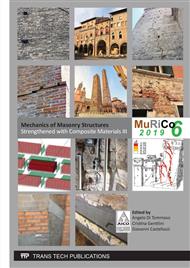p.189
p.195
p.205
p.213
p.221
p.229
p.236
p.244
p.251
Increase in Seismic Resistance for a Full-Scale Dry Stack Masonry Arch Subjected to Hinge Control
Abstract:
The seismic vulnerability and resulting damages to vaulted masonry is continuously observed with each new earthquake. The understanding of these systems is quite strong, and reinforcement strategies and techniques are continually advancing. Unfortunately, the application of reinforcement is typically applied in a way that the failure transforms directly from one of stability to strength. This direct transformation overlooks the potential behaviors of the system that exist between the two limits. To investigate and better understand the intermittent behavior of masonry arches, an in-scale dry joint masonry arch subjected to hinge control and a tilting plane loading condition was experimentally tested. The result of that experimentation revealed that the capacity can be increased and the failure defined, but the non-ideal conditions of slip and base deformations were observed as well. This work presents the second experimental campaign of a full-scale dry stack masonry arch subjected to hinge control and a tilting plane loading condition. In this campaign, the issue of slip is addressed in the arch construction, and the results show that the capacity of the full-scale arch can be increased and the failure defined.
Info:
Periodical:
Pages:
221-228
Citation:
Online since:
August 2019
Authors:
Keywords:
Price:
Сopyright:
© 2019 Trans Tech Publications Ltd. All Rights Reserved
Share:
Citation:


